Fleur-de-lis
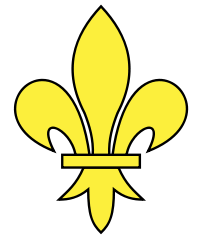
The fleur-de-lys (or fleur-de-lis, plural: fleurs-de-lis; pronounced /ˌfləː(r)dəˈliː/ (pronounced [ˌfləː(r)dəˈlɪs] in Quebec), translated from French as "lily flower") is a stylized design of either an iris or a lily that is now used purely decoratively as well as symbolically, or it may be "at one and the same time political, dynastic, artistic, emblematic and symbolic",[1] especially in heraldry.
While the fleur-de-lis has appeared on countless European coats of arms and flags over the centuries, it is particularly associated with the French monarchy on a historical context, and nowadays with the Spanish monarchy and the Grand Duchy of Luxembourg as the only remaining monarchs of the House of Bourbon.
It is an enduring symbol of France that appears on French postage stamps but has not been adopted officially by any of the French republics. By contrast, as Spain is a constitutional monarchy, the fleur-de-lis is associated with the Spanish King Juan Carlos I (of Bourbon descent) and the Kingdom of Spain.
In North America, the fleur-de-lis is often associated with areas formerly settled by France, such as Quebec and Louisiana and with Francophones in other Canadian provinces.
It is also the emblem of the Italian Province of Florence, having been added to the Medici palle in the 16th century, and of the Swiss Municipality of Schlieren. The flag of Bosnia-Hercegovina from 1992-1998 contained several fleurs-de-lis
In England, a fleur-de-lis has been part of the arms of the Norroy King of Arms for hundreds of years, and remains part of the arms of the present Norroy and Ulster King of Arms.
The Welsh poet Hedd Wyn used this as his alias when he won his seat at the National Eisteddfod of Wales (Eisteddfod Genedlaethol Cymru).
Fleurs-de-lis appear on military insignia and the logos of many different organizations, and during the 20th century it was adopted by various Scouting organizations worldwide for their badges. Architects and designers may use it alone or as a repeated motif in a wide range of contexts, from ironwork to bookbinding, especially where a French context is being implied. As a religious symbol it may represent the Trinity, or be an iconographic attribute of the archangel Gabriel, notably in representations of the Annunciation.[2] In such contexts, it is associated with the Virgin Mary.
The symbol is also often used on a compass rose to mark the north direction, a tradition started by Flavio Gioja.
It is represented in Unicode at U+269C FLEUR-DE-LIS (⚜).
Contents |
Earliest usage

Fleur-de-lis is literally translated from French as "lily flower", and is widely thought to be a stylized version of the species Iris pseudacorus. Decorative ornaments that resemble the fleur-de-lis have appeared in the artwork from the earliest civilizations.
"The use for ornamental or symbolic purposes of the stylised flower usually called fleur de lis is common to all eras and all civilizations. It is an essentially graphic theme found on Mesopotamian cylinders, Egyptian bas-reliefs, Mycenean potteries, Sassanid textiles, Gaulish coins, Mameluk coins, Indonesian clothes, Japanese emblems and Dogon totems. The many writers who have discussed the topic agree that it has little to do graphically with the lily, but disagree on whether it derives from the iris, the broom, the lotus or the furze, or whether it represents a trident, an arrowhead, a double axe, or even a dove or a pigeon. It is in our opinion a problem of little importance. The essential point is that it is a very stylised figure, probably a flower, that has been used as an ornament or an emblem by almost all civilizations of the old and new worlds."[3]
It has consistently been used as a royal emblem, though different cultures have interpreted its meaning in varying ways. Gaulish coins show the first Western designs which look similar to modern fleurs-de-lis.[4] In the East it was found on the gold helmet of a Scythian king (illustration) uncovered at the Ak-Burun kurgan and conserved in Saint Petersburg's Hermitage Museum.[5]
Royal symbol
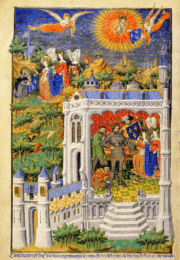

King Clovis I
By the 12th century the fleur-de-lis had become the heraldic emblem of the Capetian kings of France, whose court propaganda traced the first adoption of the fleur-de-lis to the conversion of the Frankish King Clovis I in 493.[6] The story takes various forms, many of which relate to Clovis' conversion, and support the claim of the anointed Kings of France that their authority came directly from God, without the mediation of either the Emperor or the Pope.
Anne Lombard-Jourdan[7] traces the fleur-de-lis to a transformation of the Merovingian crista, represented on their coinage, which had the form of a Greek cross with the horizonals curved upwards on either side. Though Lombard-Jourdan associates the emblem with a Romano-Gallic sanctuary Christianized as the Basilica of Saint-Denis in a seamless continuity, most scholars[8] would hesitate to pursue the sign so far.
Some versions of the legend enhance the mystique of royalty by describing a vial of oil sent from heaven to anoint and sanctify Clovis at his coronation,[9] perhaps brought by a dove to Saint Remigius. Another variation says a lily appeared at Clovis' baptismal ceremony as a gift of blessing from an apparition of the Blessed Virgin Mary, who is often associated with the flower.[10]
Clovis' Burgundian wife, Clotilde, later to be Saint Clothilda, is usually significant in these stories. As well as her part in encouraging her husband to become a Christian, her presence helps emphasise the importance of Burgundy's support for the monarch.[11]
A story which places less emphasis on Christianity and the divine right of the French kings tells of Clovis putting a flower in his helmet just before his victory at the Battle of Vouillé, leading him to choose the fleur-de-lis as a royal symbol.[12]
From Frankish to French kings
The graphic evolution of crita to fleur-de-lis was accompanied by textual allegory. By the late 13th century, an allegorical poem by Guillaume de Nangis (d. 1300), written at the abbey of Joyenval at Chambourcy, relates how the golden lilies on an azure ground were miraculously substituted for the crescents on Clovis' shield, a projection into the past of contemporary images of heraldry. Through this propagandist connection to Clovis, the fleur-de-lis has been taken in retrospect to symbolize all the Christian Frankish kings, most famously Charlemagne.
In the 14th century French writers asserted that the monarchy of France, which developed from the Kingdom of the West Franks, could trace its heritage back to the divine gift of royal arms received by Clovis. This story has remained popular, even though scepticism started in the 17th century and modern scholarship has established that the fleur-de-lis was a religious symbol before it was a true heraldic symbol.[13] Along with true lilies, it was associated with the Virgin Mary, and in the 12th century Louis VI and Louis VII started to use the emblem, on sceptres for example, so connecting their rulership with this symbol of saintliness. Louis VII ordered the use of fleur-de-lis clothing in his son Philip's coronation in 1179,[14] while the first visual evidence of clearly heraldic use dates from 1211: a seal showing the future Louis VIII and his shield strewn with the "flowers".[15] Until the late 14th century the French royal coat of arms was Azure semé-de-lys Or (a blue shield "seeded" (semé) with small golden fleurs-de-lis), but Charles V of France changed the design from an all-over scattering to a group of three in about 1376.[a][b] These two coats are known in heraldic jargon as France Ancient and France Modern respectively.
In the reign of King Louis IX (St. Louis) the three petals of the flower were said to represent faith, wisdom and chivalry, and to be a sign of divine favour bestowed on France.[16] During the next century, the 14th, the tradition of Trinity symbolism was established in France, and then spread elsewhere.
In 1328, King Edward III of England inherited a claim to the crown of France, and about 1340 he accordingly quartered France Ancient with the arms of the Kingdom of England.[c] After the kings of France adopted France Modern, the kings of England imitated them from about 1411.[17] The monarchs of England (and later of Great Britain) continued to quarter the French arms until 1801, when George III abandoned his formal claim to the French throne.
King Charles VII ennobled Joan of Arc's family on 29 December 1429 with an inheritable symbolic denomination. The Chamber of Accounts in France registered the family's designation to nobility on 20 January 1430. The grant permitted the family to change their surname to du Lys.
France Modern remained the French royal standard, and with a white background was the French national flag until the French Revolution, when it was replaced by the tricolor of modern-day France. The fleur-de-lis was restored to the French flag in 1814, but replaced once again after the revolution against Charles X of France in 1830.[d] In a very strange turn of events after the end of the Second French Empire, where a flag apparently influenced the course of history, Henri, comte de Chambord, was offered the throne as King of France, but he would agree only on condition that the French give up the tricolor and bring back the white flag with fleurs-de-lis.[18] His condition was rejected and France became a republic.
France Modern was also on the coat of arms of the old French province of Île-de-France (for instance, as a badge on the uniforms of the local gendarmerie).
Other European monarchs and rulers

Fleurs-de-lis feature prominently in the Crown Jewels of England and Scotland. In English heraldry, they are used in many different ways, and can be the cadency mark of the sixth son.
The tressure flory-counterflory (flowered border) has been a prominent part of the design of the Scottish royal arms and Royal Standard since James I of Scotland.[e]
The treasured fleur-de-luce he claims
To wreathe his shield, since royal James
- –Sir Walter Scott, The Lay of the Last Minstrel[19]
In Florentine fleurs-de-lis,[f] the stamens are always posed between the petals. This heraldic charge is often known as the Florentine lily to distinguish it from the conventional design. As an emblem of the city, it is therefore found in icons of the bishop Zenobius.[20] The currency of Florence, the fiorino, was decorated with it, and it influenced the appearance and name of the Hungarian forint and other florins. Elsewhere in Italy, fleurs-de-lis have been used for some papal crowns[g] and coats of arms, Farnese Dukes of Parma, and by some doges of Venice.
The fleur-de-lis was also the symbol of the House of Kotromanić, a ruling house in medieval Bosnia allegedly in recognition of the Angevin, where the flower is thought of as a Lilium bosniacum. It was used on the Bosnia and Herzegovina flag between 1992 and 1998.[h] Today, fleur-de-lis is a national symbol of Bosniaks,[i] one of three Bosnian constitutive ethnic groups, the other two being Serbs and Croats.
Other countries using the emblem heraldically include Serbia and Spain in recognition of the Bourbons.
The heraldic fleur-de-lis is widespread: among the numerous cities which use it as a symbol are some whose names echo the word 'lily', for example, Lille, France and Liljendal, Finland. This is called canting arms in heraldic terminology. As a dynastic emblem it has also been very widely used: not only by noble families but also, for example, by the Fuggers, a medieval banking family.
North America
Fleurs-de-lis crossed the Atlantic along with Europeans going to the New World, especially with French settlers. Their presence on North American flags and coats of arms usually recalls the involvement of French settlers in the history of the town or region concerend, and in some cases the persisting presence there of a population descended from such settlers.
The Fleur-de-lis appears on the flags of Quebec[j] and Nova Scotia in Canada, and south of the border on that of Detroit (originally a French name, though at present pronounced quite differently), New Orleans, and elsewhere. The Acadiana[k] region and various cities in southern Louisiana, such as Lafayette, New Orleans and Baton Rouge, also use the fleur-de-lis. On 9 July 2008, Louisiana governor Bobby Jindal signed a bill into law making the fleur-de-lis an official symbol of the state.[21]
It is also used in several places whose name came from one of the French King Louis: amongst them, the flag of Louisville, Kentucky and St. Louis, Missouri where the three-petalled symbol also denotes the convergence of the Mississippi, Missouri and Illinois Rivers.
Coats of arms and flags
| ^ French arms before 1376 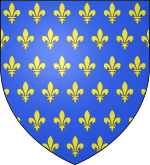 |
^ French arms after 1376  |
^ The arms of Edward III, including the fleur-de-lis; similar arms were used by subsequent English monarchs 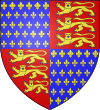 |
^ Standard of the French royal family prior to 1789 and from 1815 to 1830  |
^ Scottish royal arms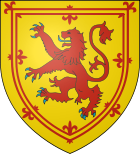 |
^ Fleur-de-lis of Florence |
| ^ Fleur-de-lis in the coat of arms of Pope Paul VI 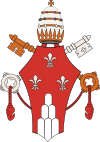 |
^ Fleur-de-lis of Bosnia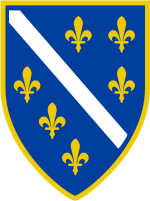 |
^ National symbol of Bosniaks |
^ Flag of Quebec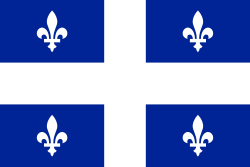 |
^ Flag of Acadiana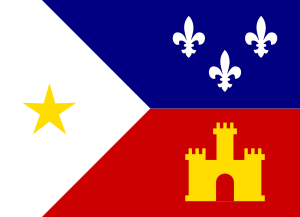 |
Symbolism in religion and art

In the Middle Ages the symbols of lily and fleur-de-lis (lis is French for "lily") overlapped considerably in religious art. Michel Pastoureau, the historian, says that until about 1300 they were found in depictions of Jesus, but gradually they took on Marian symbolism and were associated with the Song of Solomon's "lily among thorns" (lilium inter spinas), understood as a reference to Mary. Other scripture and religious literature in which the lily symbolizes purity and chastity also helped establish the flower as an iconographic attribute of the Virgin.
The fleur could also draw its design from Jewish tradition. The design is very similar to a lulav, made with a palm frond which sticks up straight and the branches of willow and myrtle trees, which are not as rigid.
In medieval England, from the mid-12th century, a noblewoman's seal often showed the lady with a fleur-de-lis, drawing on the Marian connotations of "female virtue and spirituality".[22] Images of Mary holding the flower first appeared in the 11th century on coins issued by cathedrals dedicated to her, and next on the seals of cathedral chapters, starting with Notre Dame de Paris in 1146. A standard portrayal was of Mary carrying the flower in her right hand, just as she is shown in that church's Virgin of Paris statue (with lily), and in the centre of the stained glass rose window (with fleur-de-lis sceptre) above its main entrance. The flowers may be "simple fleurons, sometimes garden lilies, sometimes genuine heraldic fleurs-de-lis".[23] As attributes of the Madonna, they are often seen in pictures of the Annunciation, famously in those of Sandro Botticelli and Filippo Lippi. Lippi also uses both flowers in other related contexts: for instance, in his Madonna in the Forest.
The three petals of the heraldic design reflect a widespread association with the Holy Trinity,[24] a tradition going back to 14th century France,[25] added onto the earlier belief that they also represented faith, wisdom and chivalry.
"Flower of light" symbolism has sometimes been understood from the archaic variant fleur-de-luce (see Latin lux, luc- = "light"), but the Oxford English Dictionary suggests this arose from the spelling, not from the etymology.[26]
Architecture

In building and architecture, the fleur-de-lis is often placed on top of iron fence posts, as a pointed defence against intruders. It may ornament any tip, point or post with a decorative flourish, for instance, on finials, the arms of a cross, or the point of a gable. The fleur-de-lis can be incorporated in friezes or cornices, although the distinctions between fleur-de-lis, fleuron, and other stylized flowers are not always clear,[27] or be used as a motif in an all-over tiled pattern, perhaps on a floor.

It may appear in a building for heraldic reasons, as in some English churches where the design paid a compliment to a local lord who used the flower on his coat of arms. Elsewhere the effect seems purely visual, like the crenellations on the 14th century Mosque-Madrassa of Sultan Hassan.
Modern usage

- Also see North America section above.
Some modern usage of the fleur-de-lis reflects "the continuing presence of heraldry in everyday life", often intentionally, but also when users are not aware that they are "prolonging the life of centuries-old insignia and emblems".[28]
Fleurs-de-lis feature on military badges like those of the Israeli Intelligence Corps, the First World War Canadian Expeditionary Force, the 256th Infantry Brigade Combat Team and the Corps of Cadets at Louisiana State University. They may be chosen for sports teams, especially when it echoes a local flag, as with the former Quebec Nordiques National Hockey League team, the Fiorentina soccer team, the New Orleans Saints football team and the New Orleans Hornets basketball team, and in coats of arms and logos for universities (like the University of Louisiana at Lafayette and Saint Louis University and Washington University in Missouri), schools (in St. Peter, Minnesota) and companies (like the Royal Elastics shoe company). The Madison Scouts Drum and Bugle Corps have a fleur-de-lis as their official logo, with members and past members sporting exclusive fleur-de-lis tattoos. The flag of Lincolnshire, county in England, has had a fleur-de-lis in the middle since 2005. It is also one of the symbols of the American woman's fraternity Kappa Kappa Gamma, and the American men's fraternity Alpha Epsilon Pi as well as the international coed service fraternity Alpha Phi Omega. Marc-Andre Fleury, goalie for the Pittsburgh Penguins, has a fleur-de-lis logo on his mask.
The symbol may be used in less traditional ways. After Hurricane Katrina many New Orleanians of varying ages and backgrounds were tattooed with "one of its cultural emblems" as a "memorial" of the storm, according to a researcher at Tulane University.[29] The US Navy Blue Angels have named an elegant looping flight demonstration manoeuvre after the flower as well, and there are even two surgical procedures called "after the fleur."
The Chevrolet Corvette also takes note of the fleur-de-lis and incorporated it into the original Corvette emblem. At the time, Chevrolet was conducting research on various emblem designs for the 1953 and 1954 passenger cars. They looked at the Louis Chevrolet family history in an attempt to discover a crest or some type of heraldry that they could utilize. Unfortunately, they came up empty, but they did realize that Chevrolet is a French name and the fleur-de-lis (flower of the lily) is a French symbol meaning peace and purity.[30]
Symbol of Scouting
The fleur-de-lis is the main element in the logo of most Scouting organizations, representing a major theme in Scouting: the outdoors and wilderness. The World Scout Emblem of the World Organization of the Scout Movement, has elements of which are used by most national Scout organizations. The symbol was chosen by Robert Baden-Powell as it had been the arm-badge of those soldiers qualified as "Scouts" (reconnaissance specialists) when BP served in the British Army. The classical description of this shape in Scouting literature connects the compass rose with the purpose of Scouting's principles -- namely that Scouting gives one's life direction.
In literature
The symbol has featured in modern fiction on historical and mystical themes, as in the bestselling novel The Da Vinci Code and other books discussing the Priory of Sion. It recurs in French literature, where examples well-known in English translation include the fleur-de-lis character in The Hunchback of Notre Dame by Victor Hugo, and the reference in Dumas' The Three Musketeers to the old custom of branding a criminal with the sign. (Fleurdeliser in French). During the reign of Elizabeth I of England, known as the Elizabethan era, it was a standard name for an iris, a usage which lasted for centuries,[31] but occasionally refers to lilies or other flowers. It also appeared in the novel A Confederacy of Dunces by John Kennedy Toole on a sign composed by the main character.
- The lilly, Ladie of the flowring field,
- The Flowre-deluce, her louely Paramoure
- Edmund Spenser, The Faerie Queene, 1590[32]
See also
- Trefoil
- Black Madonna of Częstochowa
- Prince of Wales's feathers
- Tree of life
- Palmette
References
- ↑ Michel Pastoureau, Heraldry: its origins and meaning translated by Francisca Garvie (Thames and Hudson 1997), ISBN 0-500-30074-7, p.98
- ↑ Hall, James (1974). Dictionary of Subjects & Symbols in Art. Harper & Row. ISBN 0-06-433316-7. p.124.
- ↑ Michel Pastoureau (2006) Traité d'Héraldique, "Treatise on Heraldry", translated by François R. Velde
- ↑ Michel Pastoureau, Heraldry: its origins and meaning p.99
- ↑ Gold helmet of Scythian chief found at Ak Burun, 6th century B.C.
- ↑ Lewis, Philippa and Gillian Darley (1986) Dictionary of Ornament
- ↑ Lombard-Jourdan, 1991. Fleur-de-lis et oriflamme:signes céleste du royaume de France (Paris: C.N.R.S.); Lombard-Jourdan traces an archaeology of beliefs through material representations.
- ↑ Such as Brigitte Bedos-Rezak, reviewing Lombard-Jourdan in Speculum 69.1 (January 1994):205-207).
- ↑ Ralph E. Giesey, "Models of Rulership in French Royal Ceremonial" in Rites of Power: Symbolism, Ritual, and Politics Since the Middle Ages ed. Wilentz (Princeton 1985) p43
- ↑ A.C. Fox-Davies, A Complete Guide to Heraldry (London 1909) p273
- ↑ British Library commentary on the legend presented in the Bedford Book of Hours.
- ↑ François R. Velde
- ↑ Michel Pastoureau, Heraldry: its origins and meaning p.99-100
- ↑ Fox-Davies, A Complete Guide to Heraldry p274
- ↑ Michel Pastoureau, Heraldry: its origins and meaning p.100
- ↑ Chronicles of Guillaume de Nangis quoted in Nouvelle collection des mémoires pour servir a l'histoire de France (1839)]
- ↑ Fox-Davies
- ↑ Pierre Goubert, The Course of French History, translator Maarten Ultee, (Routledge 1991) p.267
- ↑ Sir Walter Scott (1833) The Complete Works of Sir Walter Scott, Volume 1 of 7, Canto Fourth, VIII, NY: Conner and Cooke
- ↑ Hall, James (1974). Dictionary of Subjects & Symbols in Art. Harper & Row. ISBN 0-06-433316-7. p.124.
- ↑ Fleur-de-lis Now Official State Symbol KTAL NewsChannel 6 - NBC. Accessed 09 July 2008
- ↑ Susan M. Johns, Noblewomen, Aristocracy and Power in the Twelfth-Century Anglo-Norman Realm (Manchester 2003) p130
- ↑ Michel Pastoureau, Heraldry: its origins and meaning p.100
- ↑ F.R.Webber, Church Symbolism 1938 (Kessinger 2003) p.178
- ↑ Michel Pastoureau, Heraldry: its origins and meaning p.99
- ↑ A "fanciful derivation", Oxford English Dictionary (1989)
- ↑ http://fr.wikisource.org/wiki/Dictionnaire_raisonn%C3%A9_de_l'architecture_fran%C3%A7aise_du_XIe_au_XVIe_si%C3%A8cle_-_Tom e_5,_Flore
- ↑ Michel Pastoureau, Heraldry: its origins and meaning p.93-94
- ↑ Times-Picayune, July 16 2006
- ↑ Corvette logo 1953
- ↑ OED
- ↑ Edmund Spenser, Faerie Queene 2:vi